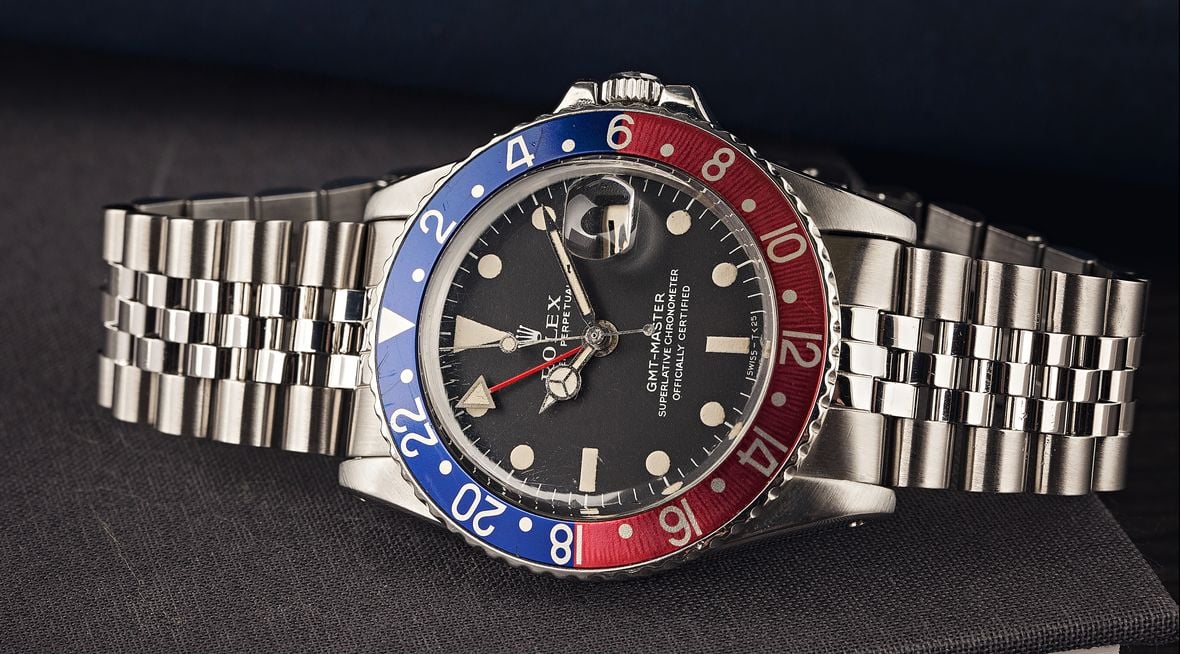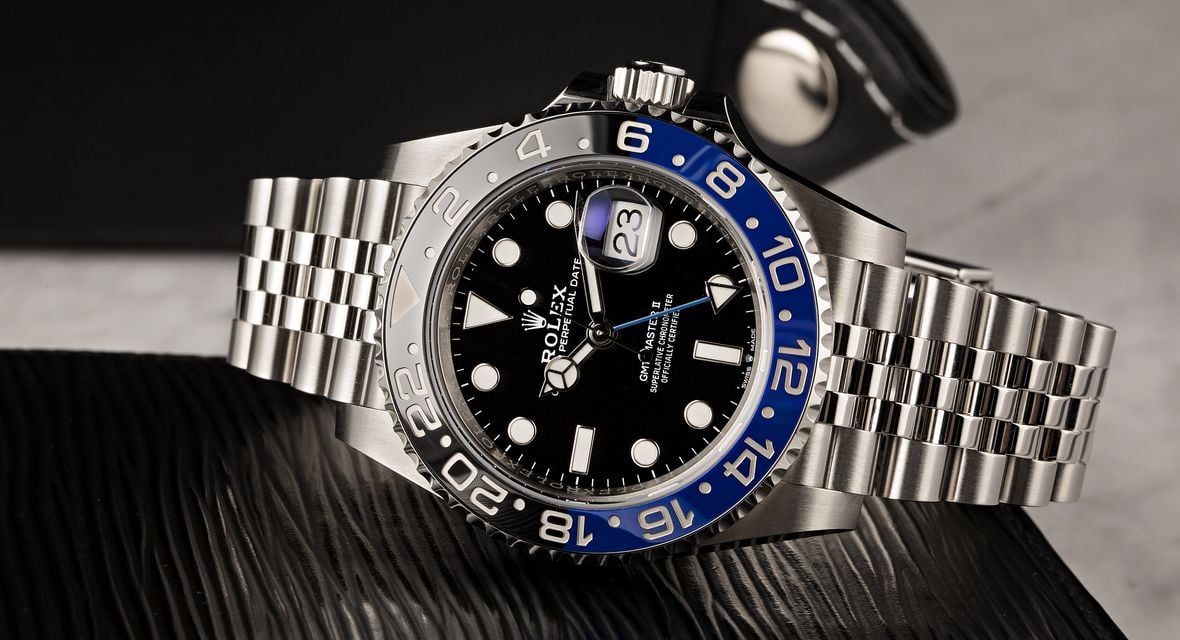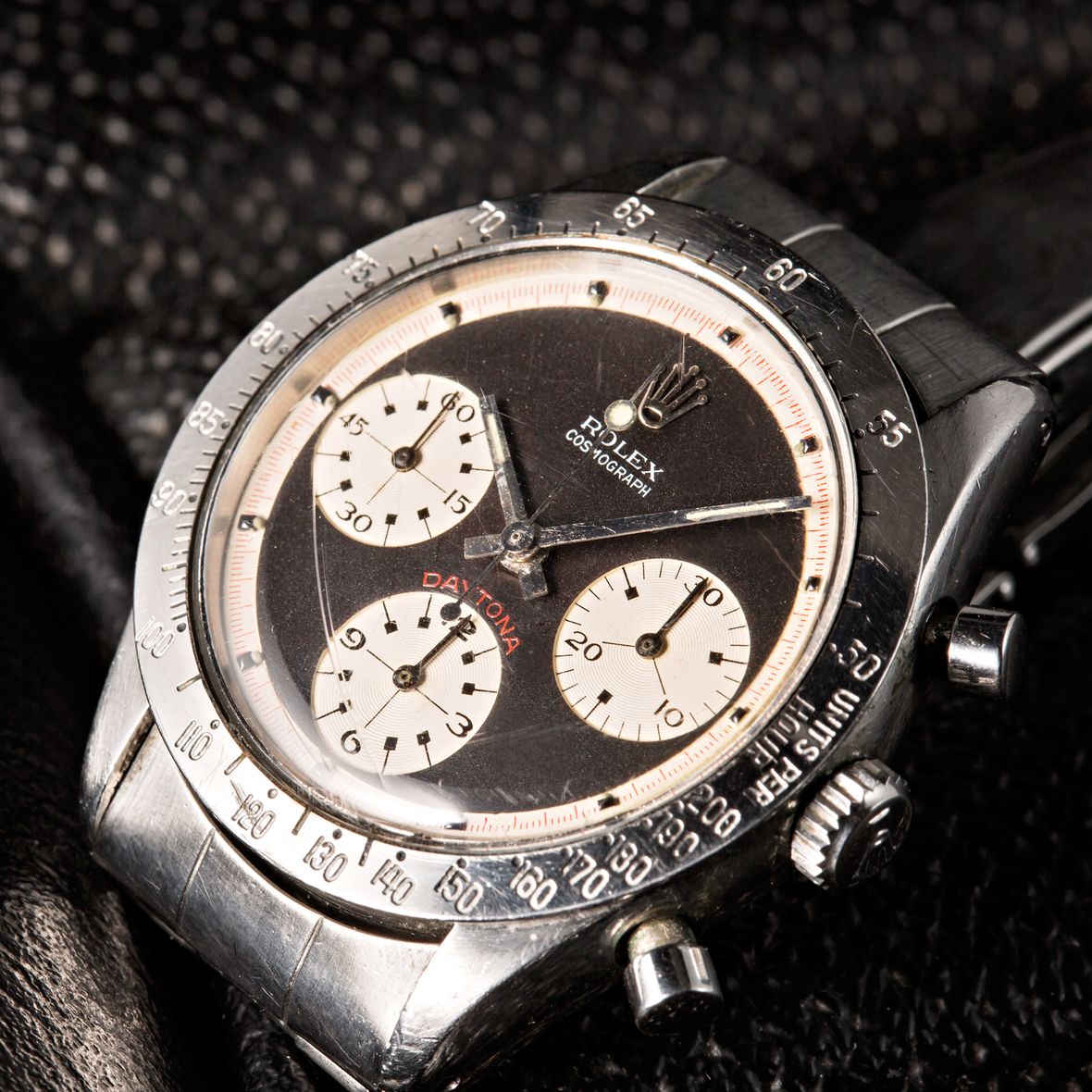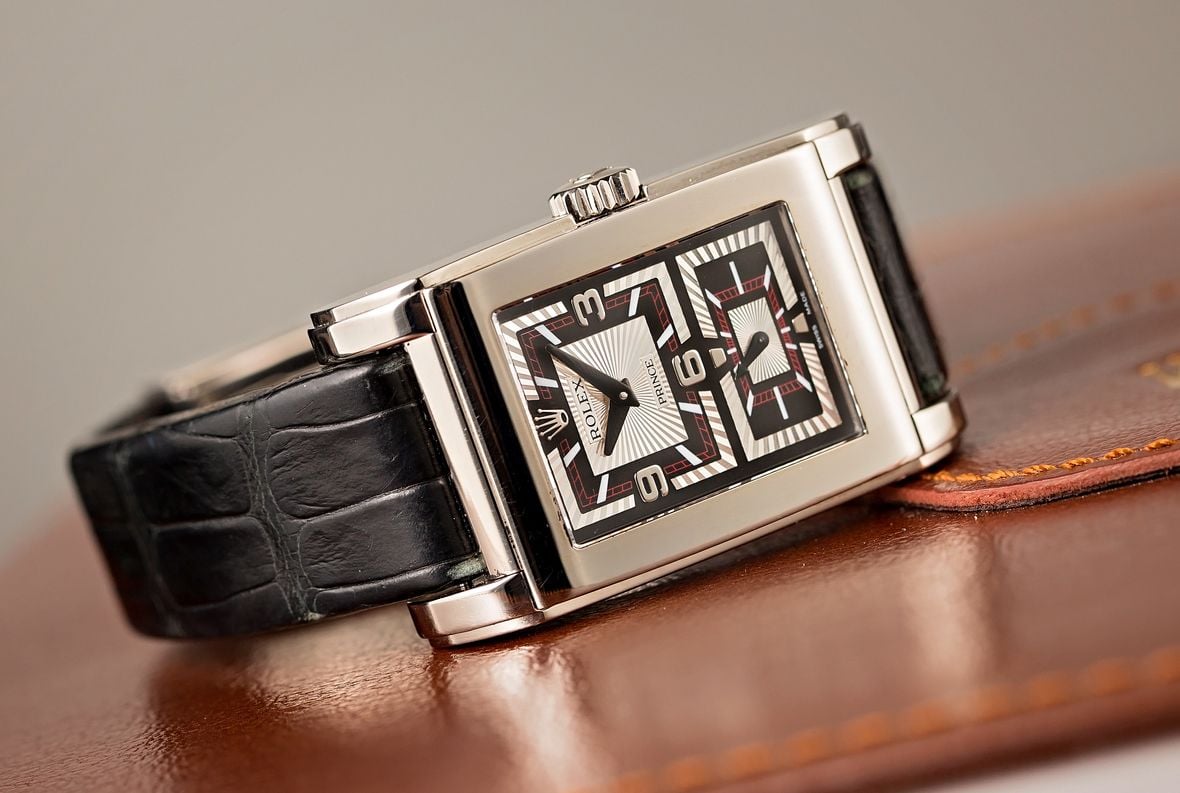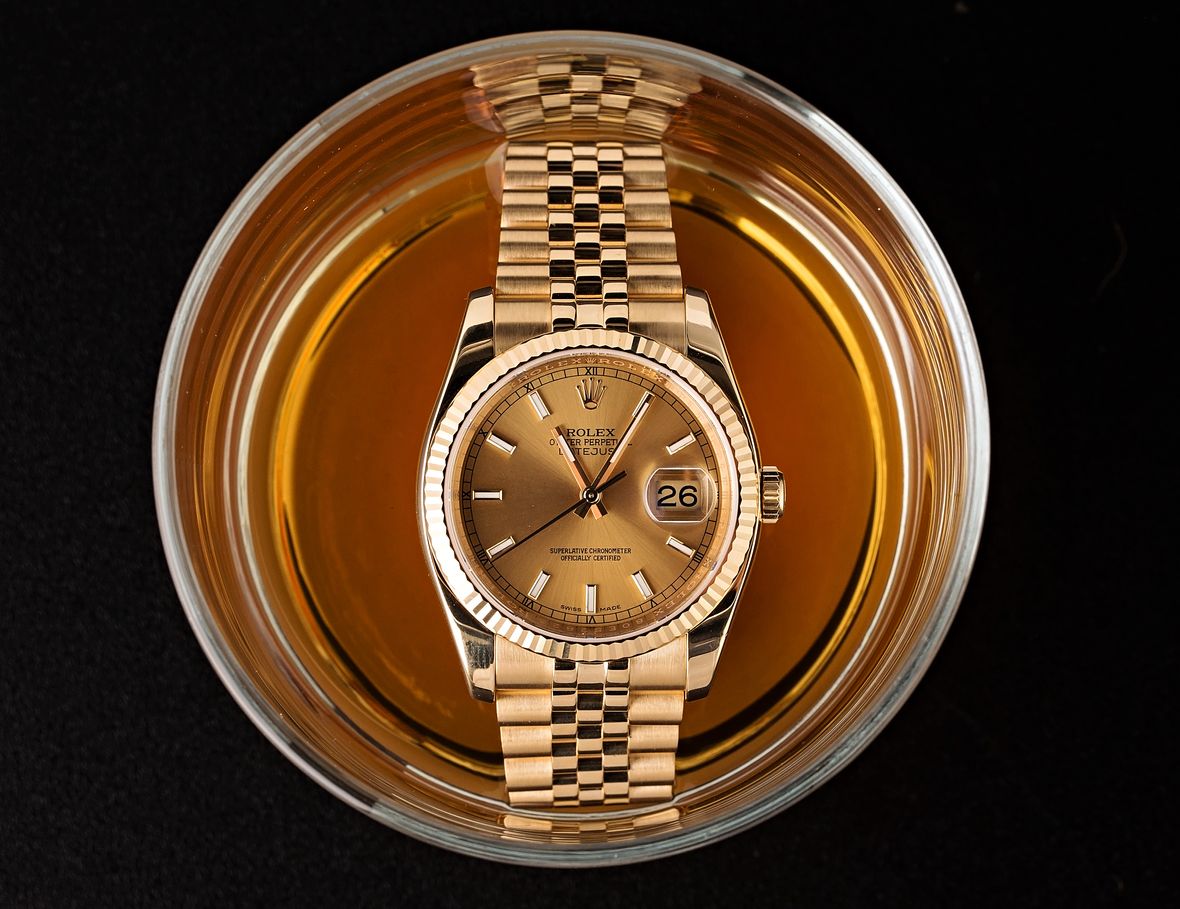Alongside a date and chronograph, a GMT function is arguably the most useful and popular complication that luxury watch models can have. The ability to keep track of time in multiple locations simultaneously has a genuine real-world application, in a way that a moonphase indicator or minute repeater (for example) does not, despite the latter two’s inflated price tags and greater desirability among collectors.
GMT watches have existed since the 1950s when the huge rise in transcontinental air travel brought about the novel experience of jetlag. Research by American airline company Pan Am suggested a watch that could display the time in both the wearer’s current city and that of the eventual destination went some way in helping stave off the worst effects of the phenomenon. As a result, they teamed up with Rolex to create a timepiece that could do just that for their pilots and crew, with the eventual outcome being the legendary Rolex GMT-Master.
Since then, this genre of wristwatches has experienced exponential growth, with just about every luxury watch manufacturer offering their own versions – either following Rolex’s general blueprint or otherwise giving us their personal take on the challenge. That means the industry is pretty well stocked with GMT watches, and choosing between them can sometimes be a bit of a challenge. Below, we have selected 10 of our favorite GMT watches, both modern and vintage, from a variety of brands to give you as diverse a spread as possible. You will find plenty of variety in terms of aesthetics, functionality, and price, but all get our seal of approval, so read on to learn more.
What is a GMT Watch?

About GMT Watches
Before we go any further, let’s just nail down what exactly is a GMT watch. The term is often used interchangeably with ‘dual time zone watch’ but the two are not exactly the same.
A dual time zone watch shows two different times, at the same time. The second is usually displayed on a separate sub-dial, marked with a 12-hour scale. Because of that, there is often also a night/day indicator included somewhere to allow wearers to keep abreast of whether their secondary time zone is in the AM or PM. When traveling, the watch is set to read the local time on the main dial, with the sub-dial showing the ‘home’ time.
A GMT watch, on the other hand, always uses a 24-hour scale for the second time zone, most commonly located on the outside of the dial or else engraved on the bezel, which can either be fixed or rotatable. The name comes from ‘Greenwich Mean Time’ – measured from the Royal Observatory in Greenwich, London, which is the start point for the 24 global time zones.
Most GMT watches still use the method devised by Rolex for the GMT-Master, and are fitted with an additional hour hand, geared to run at half the speed of the main hand, which points out the destination time on the scale. Early examples had both hour hands mechanically linked, meaning the watch could only be used to follow two individual time zones. However, later pieces disconnected the two, so wearers could actually follow three zones by bringing a rotating bezel into play. So, what are our favorite GMT watches?
Rolex GMT-Master ref. 1675
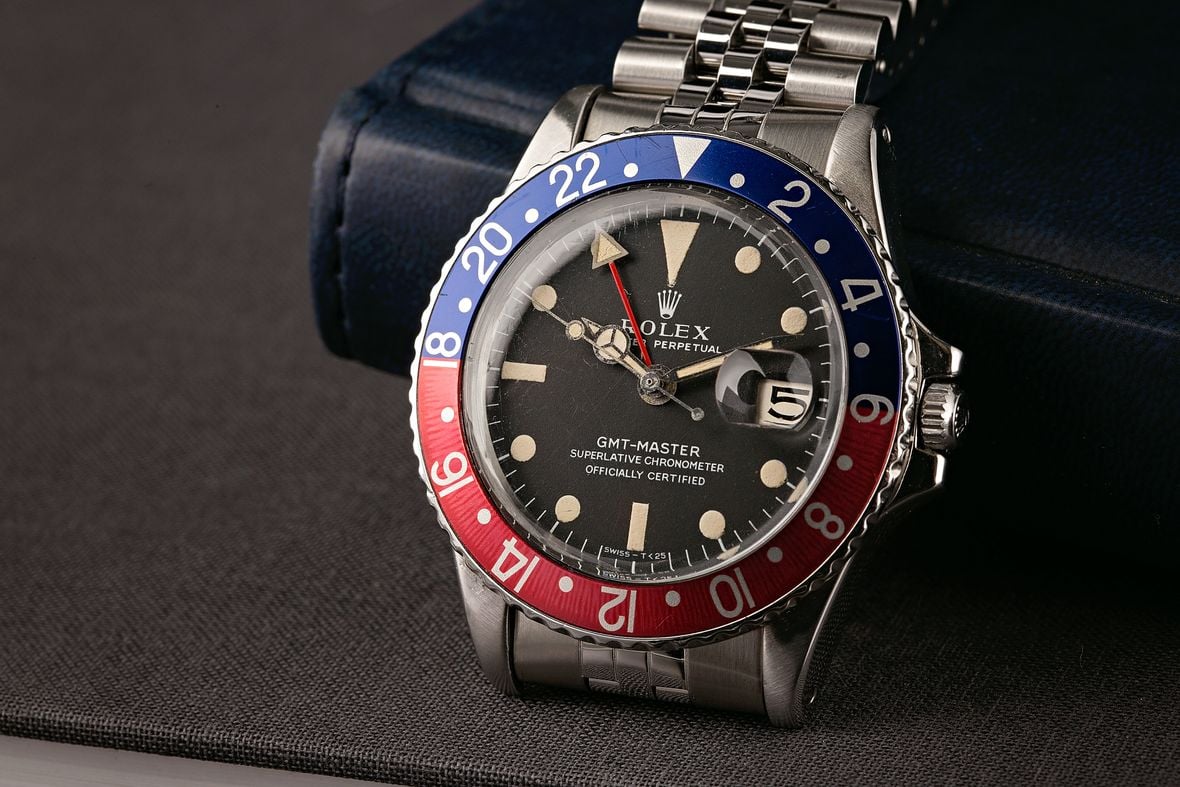
GMT-Master 1675 Key Features:
– Production Years: 1959 – 1980
– Case Size: 40mm
– Materials: Stainless Steel; Yellow Rolesor; Yellow Gold
– Functions: Time w/ Running Seconds, Date Display, GMT Functionality
– Dial: Black or Brown w Luminous Hour Markers
– Bezel: Bidirectional, Aluminum Insert w/24-hour scale
– Crystal: Acrylic (Flat w/ Cyclops Lens)
– Movement: Rolex Caliber 1565 or Caliber 1575
– Water Resistance: 50 Meters
– Strap/Bracelet: Oyster or Jubilee Bracelet
– Approx. Price: $9,000 – $100,000+
As only the second generation of Rolex’s GMT-Master range, the ref. 1675 makes a mouthwateringly tempting target for many collectors. Not only is it a genuine vintage example of the world’s favorite travelers’ watch – something that would normally put it out of reach of all but the most well-heeled. However, the GMT-Master 1675 was in production for such a long time that the pre-owned market has plenty of examples, making prices surprisingly attainable.
During its 21-year run from 1959 to 1980, the ref. 1675 went through countless changes, while simultaneously sticking to the accepted overall format we still know today. You will find pieces with either gilt or matte dials (the switchover happened around the mid ’60s), and some extremely rare variations within them, including chapter ring dials, double Swiss underline dials, and the so-called exclamation mark dials, which all keep serious collectors busy.
Similarly, the earliest models had GMT hands with small arrow tips, which were swapped for significantly larger ones during the reference’s lifespan. And, just as with the Submariner ref. 5512 that debuted the same year, the crown guards on the case also changed shape over time, going from the pointed ‘El Cornino’ style to the more rounded design we know today. The movement was upgraded as well, starting out with the Cal. 1565, which was replaced with the Cal. 1575 in 1964, and in 1972, Rolex fitted it with a hacking seconds function.
However, the GMT-Master’s story will always center around its bezel. The ref. 1675 was first offered in steel with the fabled red and blue Pepsi bezel – the color scheme both an aesthetic choice and a practical one, as it gave wearers an at-a-glance approximation of night and daytime hours. During the course of its production run, the reference 1675 was offered in both Rolesor (a combination of stainless steel and yellow gold) in the form of the ref. 1675/3 and solid 18k yellow gold as the ref. 1675/8. Between the different material options and the range of variation that exists among this single model, it is possible to spend vast sums on this vital chapter of Rolex’s history, yet excellent examples can also be had for under $10,000, which is an extremely reasonable sum for such an important watch.
Rolex GMT-Master II ref. 126719BLRO Meteorite
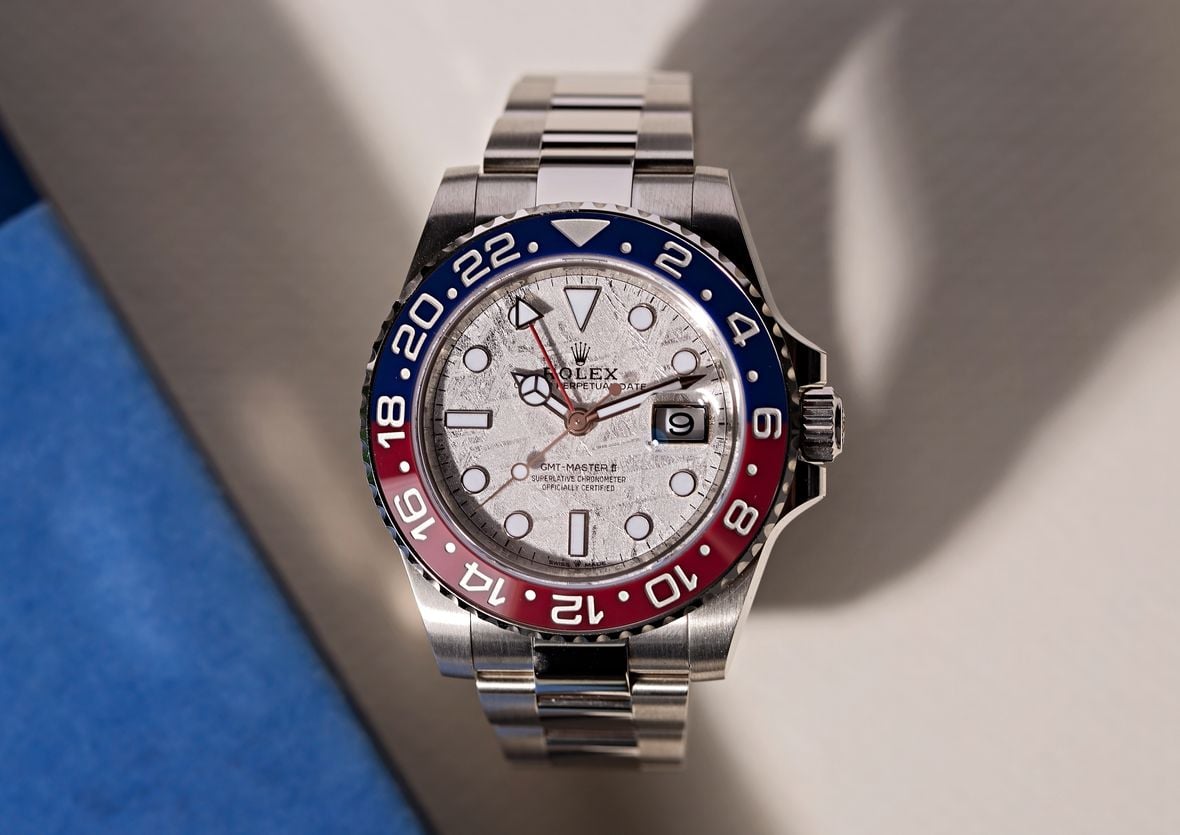
GMT-Master II 126719BLRO Key Features:
– Production Years: 2019 – Present
– Case Size: 40mm
– Materials: 18k White Gold
– Functions: Time w/ Running Seconds, Date Display, GMT Functionality
– Dial: Meteorite w/ Luminous Hour Markers
– Bezel: Bidirectional, Cerachrom Insert w/24-hour scale.
– Crystal: Sapphire (Flat w/ Cyclops Lens)
– Movement: Rolex Caliber 3285
– Water Resistance: 100 Meters
– Strap/Bracelet: Oyster Bracelet
– Approx. Price: $39,900 (New); $65,000 – $80,000 (Pre-Owned)
From a vintage classic to a future one, this modern incarnation of the GMT-Master II is a far cry from the rough and ready tool watch of the 1950s. Although the basics are the same – a 40mm case, a red and blue bezel. and an additional GMT hand, the ref. 126719BLRO is the end result (so far) of more than 60-years of tweaking, fine-tuning, and the elevation of materials.
The case is now crafted from the finest 18k white gold, forged in Rolex’s own foundry. The bezel is the brand’s proprietary Cerachrom ceramic – a scratch-proof, fade-proof, and nigh-on unbreakable material that is diamond polished and coated with a layer of platinum. Additionally, the movement inside is the latest generation Cal. 3285, complete with the revolutionary Chronergy escapement and blue Parachrom hairspring.
If all that wasn’t opulence enough, the watch also offers the ultimate in exclusivity by being topped with a dial made from a genuine meteorite. Consisting mainly of iron and nickel, meteorite is the name for a piece of a celestial object (comet, asteroid, etc.) that has traveled through space and landed on Earth. This is not the first time that Rolex has used the substance in its watches – there are a host of Datejust and Day-Date models with meteorite dials, and the Daytona was also given one this year – but it is the first time seeing it on a GMT-Master.
Meteorite is a fascinating material and one that is completely unique. Each wafer-thin slice used in the dials has its own patterns and striations, known as Widmanstätten structures, which are caused by the extreme temperature changes as the meteor crashed through the Earth’s atmosphere.
What this means is that no two examples of the ref. 126719BLRO will look the same and it also lifts the watch up as a whole. Usually fitted with black or at least very dark dials, the light silvery color of this model is a refreshing change and about as close as many of us will ever get to the mythical white-dial Albino GMT-Master rumored to have been made for PAN-AM senior directors in the 1950s. The reference 126719BLRO is a true luxury watch for the luxury traveler, and the pinnacle of Rolex GMT-Master II watches.
Rolex Explorer II ref. 16570
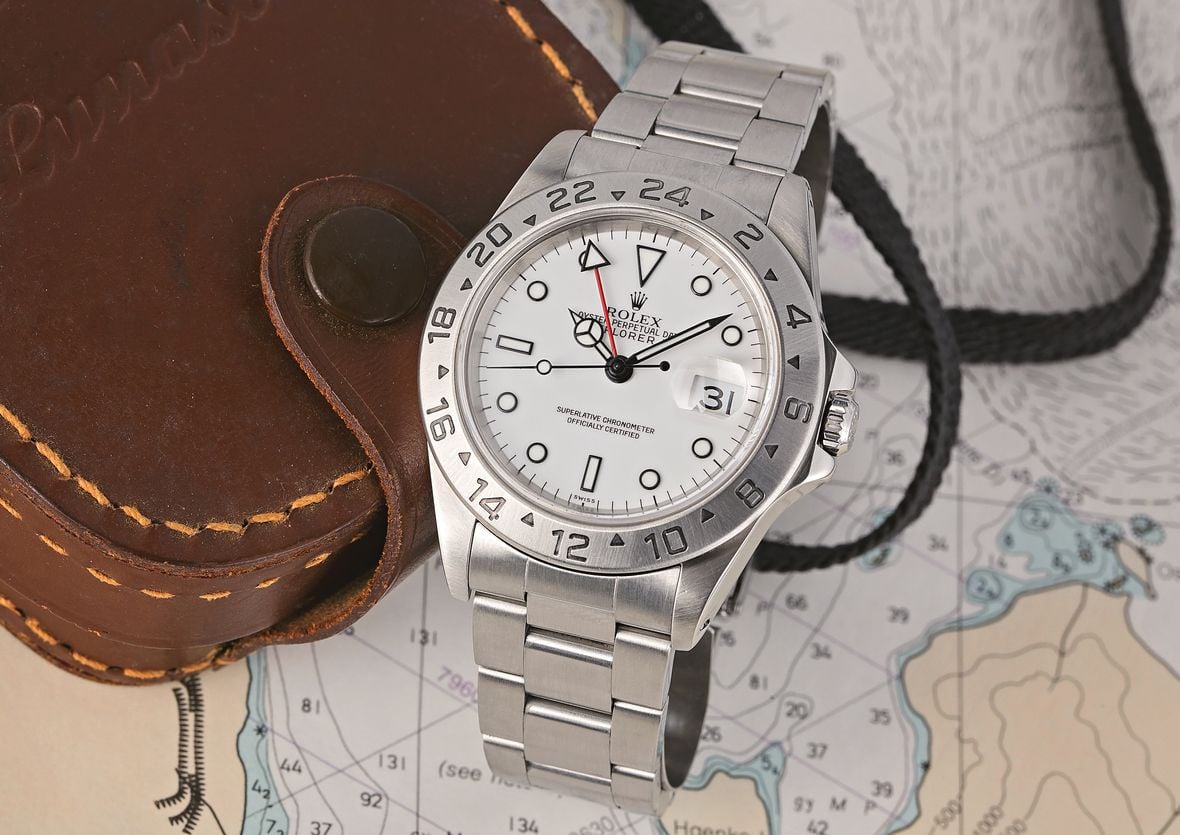
Explorer II 16570 Key Features:
– Production Years: 1989 – 2011
– Case Size: 40mm
– Materials: Stainless Steel
– Functions: Time w/ Running Seconds, Date Display, GMT Functionality
– Dial: White or Black w/ Luminou Hour Markers
– Bezel: Fixed, Stainless Steel w/ Engraved 24-Hour Scale
– Crystal: Sapphire (Flat w/ Cyclops Lens)
– Movement: Rolex Caliber 3185 or Caliber 3186
– Water Resistance: 100 Meters
– Strap/Bracelet: Oyster Bracelet
– Approx. Price: $8,000 – $15,000
The Rolex Explorer II series has always existed somewhat in the shadows of the GMT-Master range, despite the abundant similarities between the collections. The two shared not only a case for the majority of their respective runs but also the movement powering them. The ref. 16570 represented just the third generation of the watch when it emerged in 1989, and it really only differed from its predecessor (the ref. 16550) in its movement – upgrading from the short-lived Cal. 3085 to the Cal. 3185 for most of its life.
Unlike Rolex’s real icons, the Explorer II has stayed close to the brand’s tool watch roots, never having more than two options for dial colors and only ever issued in stainless steel. Even its sibling, the original Explorer, recently received a two-tone Rolesor version in stainless steel and 18k yellow gold in 2021. However, it is that single-mindedness that has gained the Explorer II a smaller but still highly enthusiastic fan base. This is a Rolex from the old school era and many believe that it is all the better for it.
The reference 16570 is actually the gateway into Rolex Explorer II ownership, with prices starting at around $8,000. For that, you get an extremely tough, versatile watch with a genuine GMT function that is a step away from the usual suspects. Available with either a white (Polar) or black dial, each has a distinct personality; the former bright, crisp and conspicuous, while the latter is understated and stealthy. The extra hour hand is the same as was used on the GMT-Master of the period, long, thin, and finished in red rather than the more popular Freccione style of the original and current examples. An Explorer II from any era is a joy and is seen by many as one of the last ‘real’ Rolex sport watches, and the ref. 16570 is the most attainable of them all.
Omega Planet Ocean 600M GMT ref. 215.30.44.22.01.001
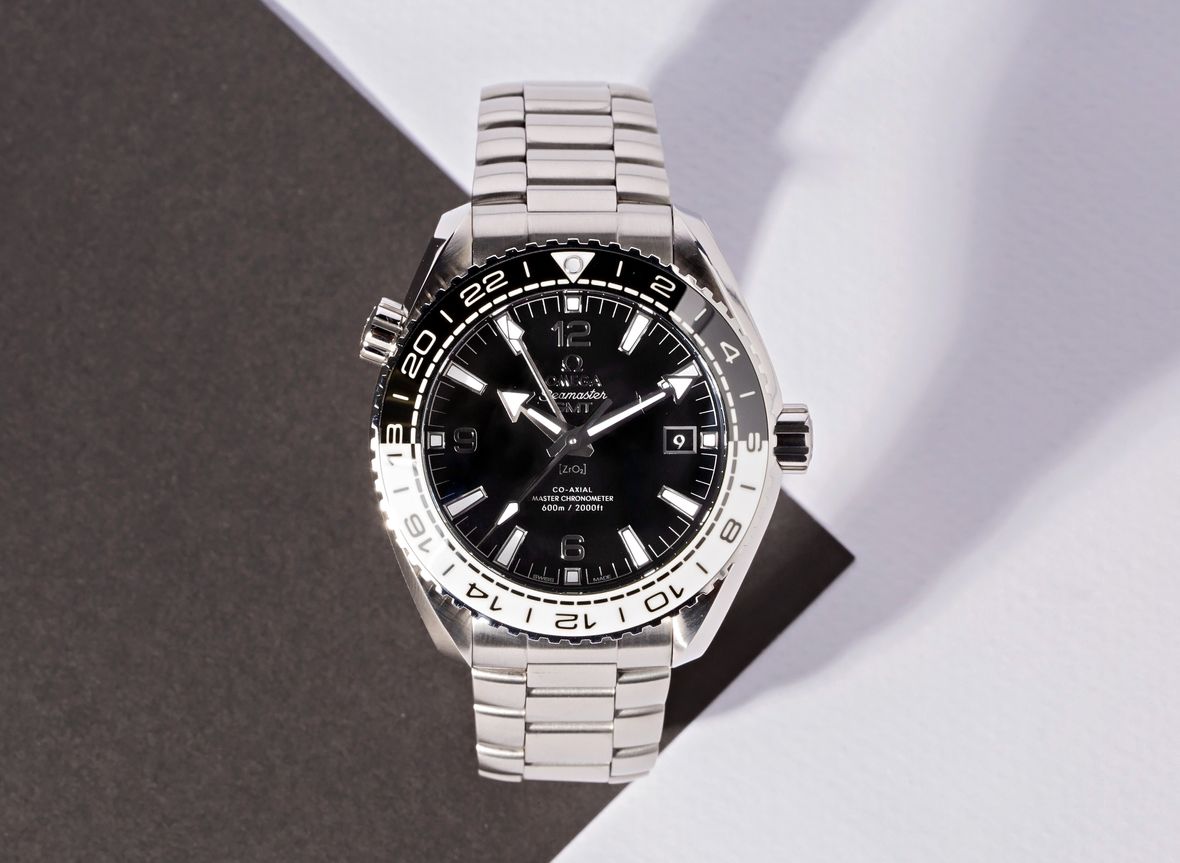
Planet Ocean GMT Key Features:
– Production Years: 2016 – Present
– Case Size: 43.5mm
– Materials: Stainless Steel
– Functions: Time w/ Running Seconds, Date Display, GMT Functionality, Helium Escape Valve
– Dial: Black w/ Luminou Hour Markers
– Bezel: Bidirectional; Black and White Ceramic w/ 24-Hour Scale
– Crystal: Sapphire (Domed)
– Movement: Omega Caliber 8906
– Water Resistance: 600 Meters
– Strap/Bracelet: Stainless Steel Bracelet
– Approx. Price: $8,000 (New); $6,500 – $9,000 (Pre-Owned)
Giving Rolex a run for its money on just about every front is Omega, whose output over the last few years has been extraordinary. The brand’s Planet Ocean range, first released in 2013, is a case in point. A bigger, deeper, stronger alternative to the fan (and James Bond) favorite Seamaster 300M series, everything here is dialed up to the nth degree, from sizes to materials to abilities. One of the most impressive is the ref. 215.30.44.22.01.001 – or to give it its snappier nickname, the Cookies & Cream.
As with the rest of the Planet Ocean range, the Cookies & Cream is primarily a dive watch, and one with a fearsome 600m water resistance rating. However, it is also the owner of the world’s first polished bi-ceramic black and white bezel, the perfect indicator of nighttime and daytime hours for its GMT function. (If you were wondering, Rolex’s Cerachrom bezels are all made from one piece of ceramic that is then treated to get two colors).
Omega’s resurgence has come as a result of the brand offering its customers a lot of watch for their money, and the Cookies & Cream Planet Ocean GMT is jam-packed with impressive features. Plus, at 43.5mm in diameter and more than 17mm tall, it is also a lot of watch in the literal sense of the word too. In addition to the bezel, the dial is also ceramic and a helium escape valve juts out at the 10 o’clock.
Inside, the movement powering the Cookies & Cream Planet Ocean GMT is a fully in-house, Co-Axial equipped Master Chronometer, accurate to a METAS-certified 0/+5 seconds a day and completely antimagnetic. A proven winner from one of the most storied watchmakers in the business, the Omega Planet Ocean Cookies & Cream is a tough one to beat.
Omega Seamaster Diver 300M GMT Chronograph ref. 212.30.44.52.01.001
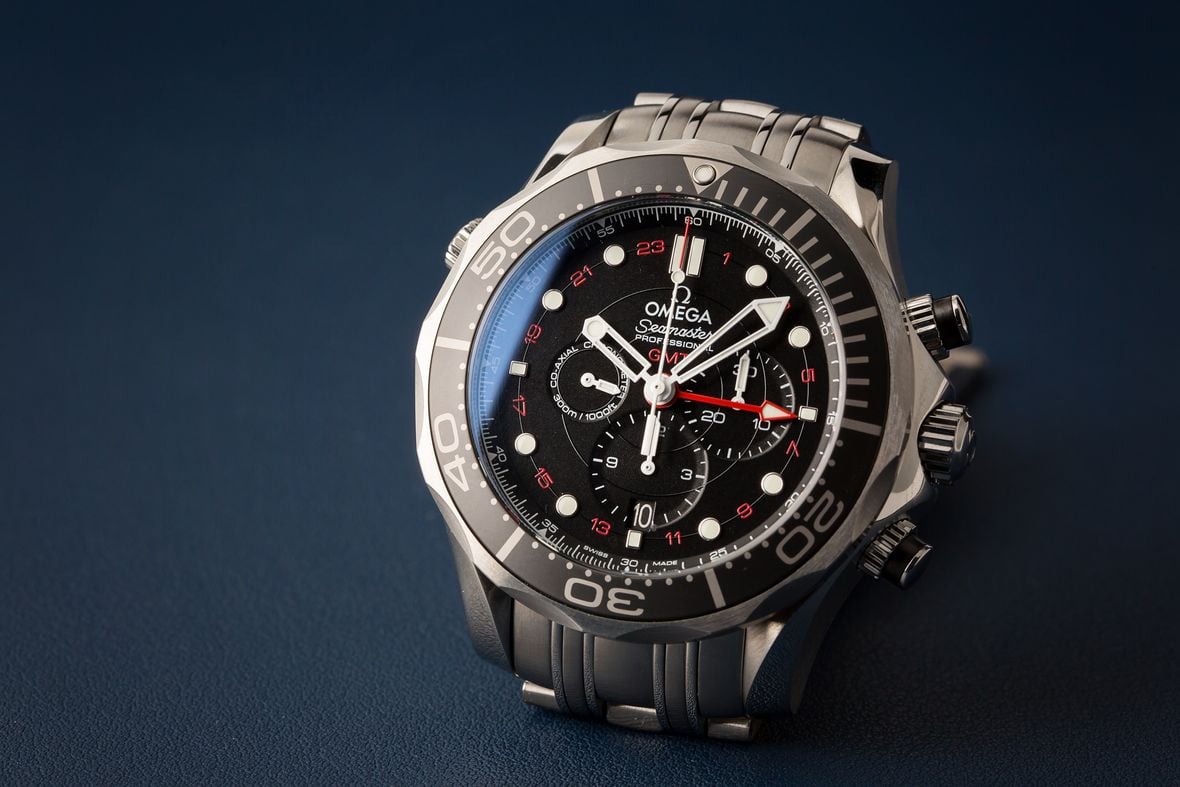
Seamaster Diver GMT Chronograph Key Features:
– Production Years: 2014 – Present
– Case Size: 44mm
– Materials: Stainless Steel
– Functions: Time w/ Running Seconds, Date Display, GMT Functionality, Helium Escape Valve
– Dial: Black w/ Luminous Hour Markers
– Bezel: Unidirectional; Grey Ceramic w/ 60-Minute Scale
– Crystal: Sapphire (Domed)
– Movement: Omega Caliber 3603
– Water Resistance: 300 Meters
– Strap/Bracelet: Stainless Steel Bracelet
– Approx. Price: $7,100 (New); $4,500 – $6,000 (Pre-Owned)
For those who like their watches with a lot going on, we give you this piece from Omega’s extensive Seamaster Diver 300M series, which manages to be a full-throated dive watch, a chronograph, and a GMT. With so much to do, the ref. 212.30.44.52.01.001 could very well have become an illegible mess, but a combination of intelligent styling and a playing surface of 44mm means that it displays all its information in a practical and readable package.
Concessions have had to be made, of course. The bezel, usually given over to a 24-hour scale on a regular GMT, is instead still a unidirectional dive bezel, inscribed with 60-minute graduations. That has relegated the second time zone markings to the outer edge of the dial where it takes a bit more effort to see them, but that is really nitpicking. The watch’s other talents make up for any inconvenience, such as the unusual ability to operate the chronograph pushers while underwater. An extremely useful function for precisely timing things like decompression stops, it sets the model apart among a sea of rivals.
Like the Planet Ocean above, there is also plenty of presence here. The Omega Seamaster Diver 300M GMT Chronograph sits high off the wrist, with a thick chunky case containing the Omega Co-Axial Caliber 3603. Based on the Piguet 1285, it features a column wheel-controlled chronograph (30-minute and 12-hour counters, with running seconds at 9 o’clock), a date display, a central GMT hand, and a co-axial escapement. COSC-certified, it beats at 4Hz and has a 52-hour reserve. Overall, if you are headed off on vacation and want just one watch to cover every possible situation and every requirement, this one has you covered.
Tudor Black Bay GMT ref. M79830RB-0001
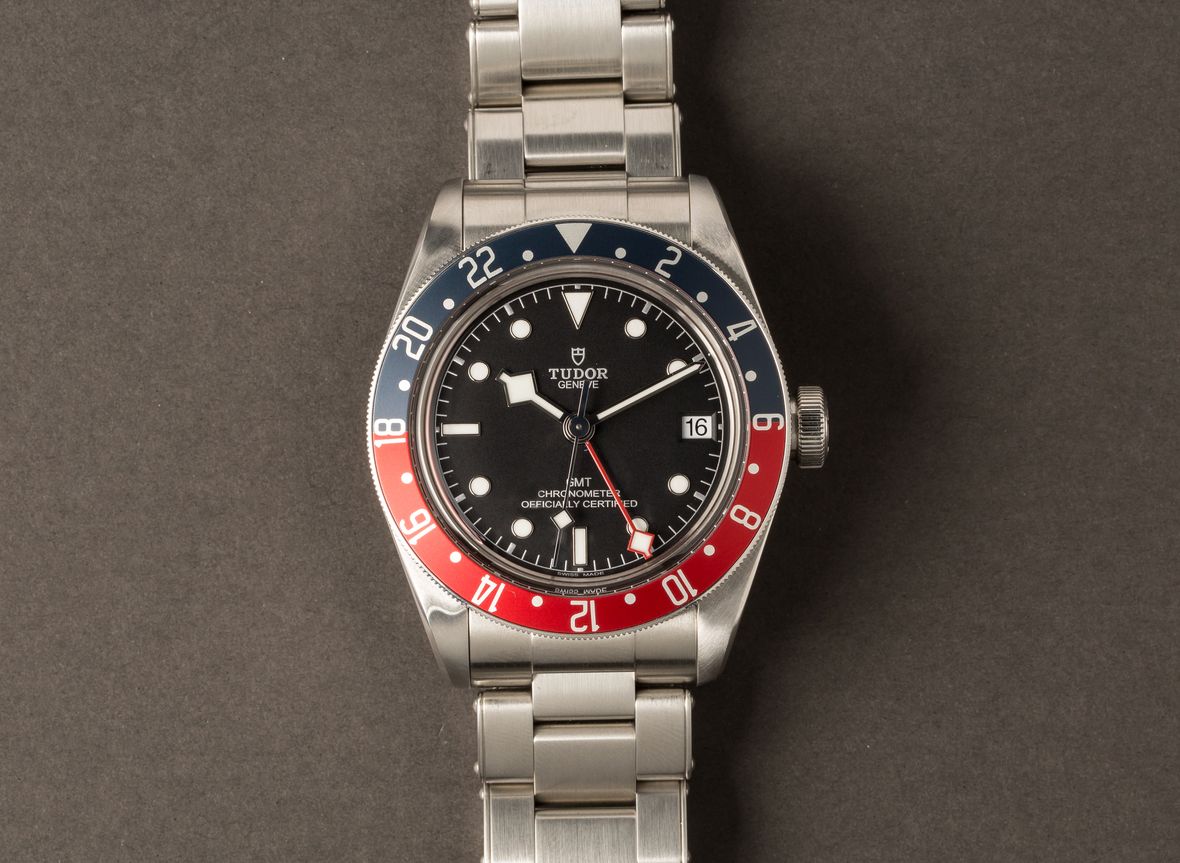
Black Bay GMT Key Features:
– Production Years: 2018 – Present
– Case Size: 41mm
– Materials: Stainless Steel
– Functions: Time w/ Running Seconds, Date Display, GMT Functionality
– Dial: Black w/ Luminous Hour Markers
– Bezel: Bidirectional, Aluminum Insert w/ 24-Hour Scale
– Crystal: Sapphire (Domed)
– Movement: Tudor Caliber MT5652
– Water Resistance: 200 meters
– Strap/Bracelet: Stainless Steel Bracelet
– Approx. Price: $4,100 (New); $3,100 – $5,800 (Pre-Owned)
Rolex sibling company Tudor has been doing great business over the last decade or so by tapping into the public’s obsession for all things vintage, and nowhere more so than with its Black Bay GMT model. Rocking up to Baselworld 2018 with the Black Bay GMT ref. M79830RB-0001, Tudor even managed to steal some of the limelight away from the long-awaited return of a stainless steel Pepsi bezel GMT-Master II from its parent company, which goes some way to proving just how well-loved this watch is among collectors and enthusiasts.
Ironically, Tudor did it by delving back into Rolex’s own archives for inspiration. The Tudor model has all the hallmarks of the first-ever Rolex GMT-Master ref. 6542, with a steel case devoid of crown guards, a matte black dial complete with chapter ring, a blue and red aluminum insert, a coin-edged bezel ring, and even a rivet-style bracelet. To that, Tudor has also drawn from its own history, adding a large 8mm crown reminiscent of the Tudor (and Rolex, for that matter) Submariner watches first seen in the 1950s and (of course) the opinion-dividing Snowflake hands.
However, unlike many brands, Tudor hasn’t gone too far with the retro detailing. There’s no beige ‘fauxtina’ on the hour markers, for instance, which can easily look a bit try-hard if overdone. Inside, nostalgia gives way to modernity, with the in-house MT5652. Tudor’s first-ever homegrown GMT movement, the COSC-certified chronometer features a 28,800vph frequency, a 70-hour power reserve, and an antimagnetic silicon hairspring.
Best of all, as with just about everything that emerges from Tudor’s facilities, is the cost of the Black Bay GMT. This slice of mid-20th century reminiscence retails at just over $4,000, which is less than half the official price of the comparable GMT-Master II, and orders of magnitude cheaper than hunting down a vintage ref. 6542.
Grand Seiko Hi-Beat GMT ref. SBGJ201
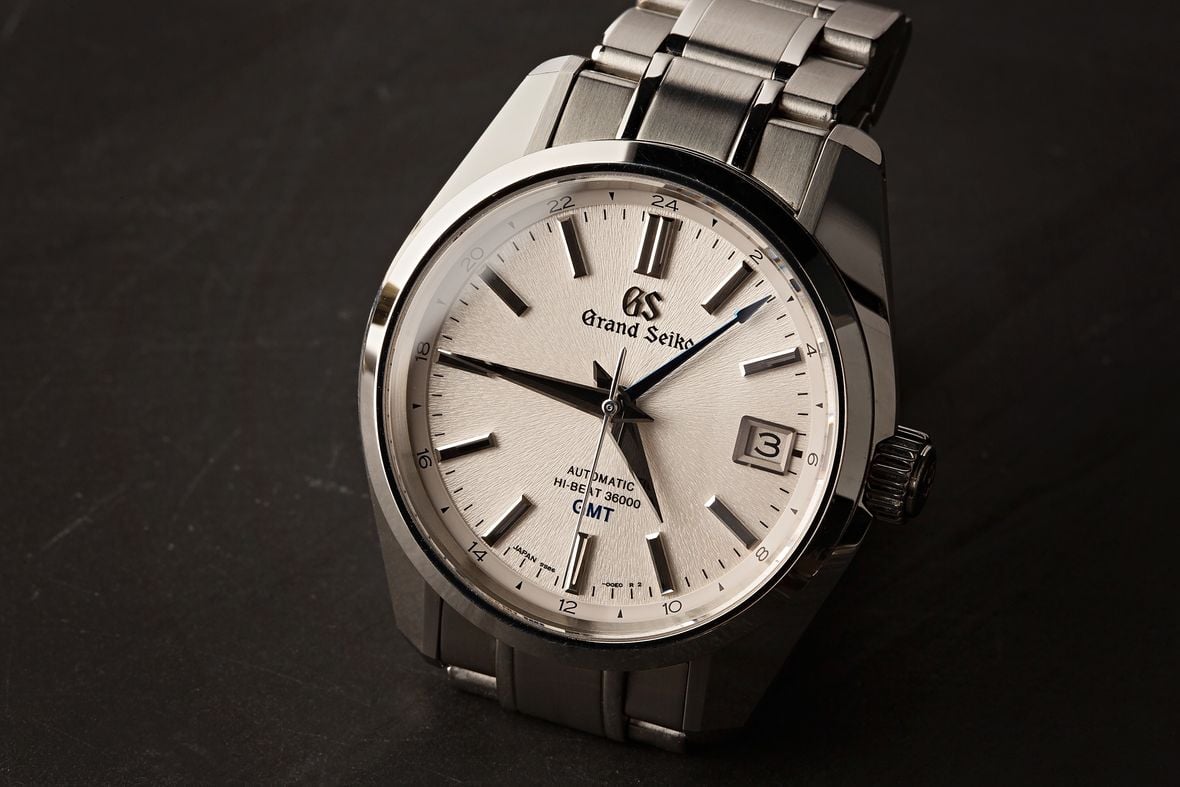
Grand Seiko SBGJ201 Key Features:
– Production Years: 2017 – Present
– Case Size: 40mm
– Materials: Stainless Steel
– Functions: Time w/ Running Seconds, Date Display, GMT Functionality
– Dial: White w/ Polished Hour Markers
– Bezel: Fixed, Stainless Steel, Smooth Style
– Crystal: Sapphire (Domed)
– Movement: Grand Seiko Caliber 9S86
– Water Resistance: 100 Meters
– Strap/Bracelet: Stainless Steel Bracelet
– Approx. Price: $7,400 (New); $4,800 – $6,700 (Pre-Owned)
A dressier example than we’ve seen so far, and one teeming with Grand Seiko’s distinctive design codes, the Hi-Beat GMT ref. SBGJ201 is a more elegant take on the travel watch theme. The 40mm steel case is a textbook example of the brand’s ‘Grammar of Design’ philosophy, a styling language devised by Seiko’s celebrated first draftsman, Taro Tanaka, with exquisite angled facets and ultra-clean geometry, highlighted by Zaratsu polishing to give an incredible mirror finish. It has been informing the look of the manufacturer’s output since the 1960s and gives their watches a shape like no other.
However, it is Grand Seiko’s dials that have been creating headlines in the last few years, most notably with the much-loved Snowflake from 2005. As with that piece, the SBGJ201 has also drawn its inspiration from the frozen landscape surrounding the Shizuku-Ishi studio (where the watchmaker’s mechanical models are built) and more specifically, the snow-capped peaks in the distance. The subtle off-white dial has been given a sunburst/lineated texture as if looking out of a car windscreen while driving through a blizzard. Named after the region’s highest mountain, the model is better known as the “Mt. Iwate” among enthusiasts of the brand.
Complimenting the face perfectly are a pair of gleaming, razor-sharp main hands and simple baton hour markers. All have beautifully executed, hand-carved bevels, while an ice blue GMT indicator points out the second time zone on the 24-hour scale around the perimeter. Although not powered by one of GS’s famed Spring Drive movements, the 9S86 is a high beat, 36,000vph caliber with a 55-hour reserve. The 10 ticks-per-second glide of the seconds hand is incredibly smooth to watch in action. An outstanding illustration of Japanese engineering and finishing, the Grand Seiko Mt Iwate GMT is a true class act.
Breitling Navitimer World ref. A2432212
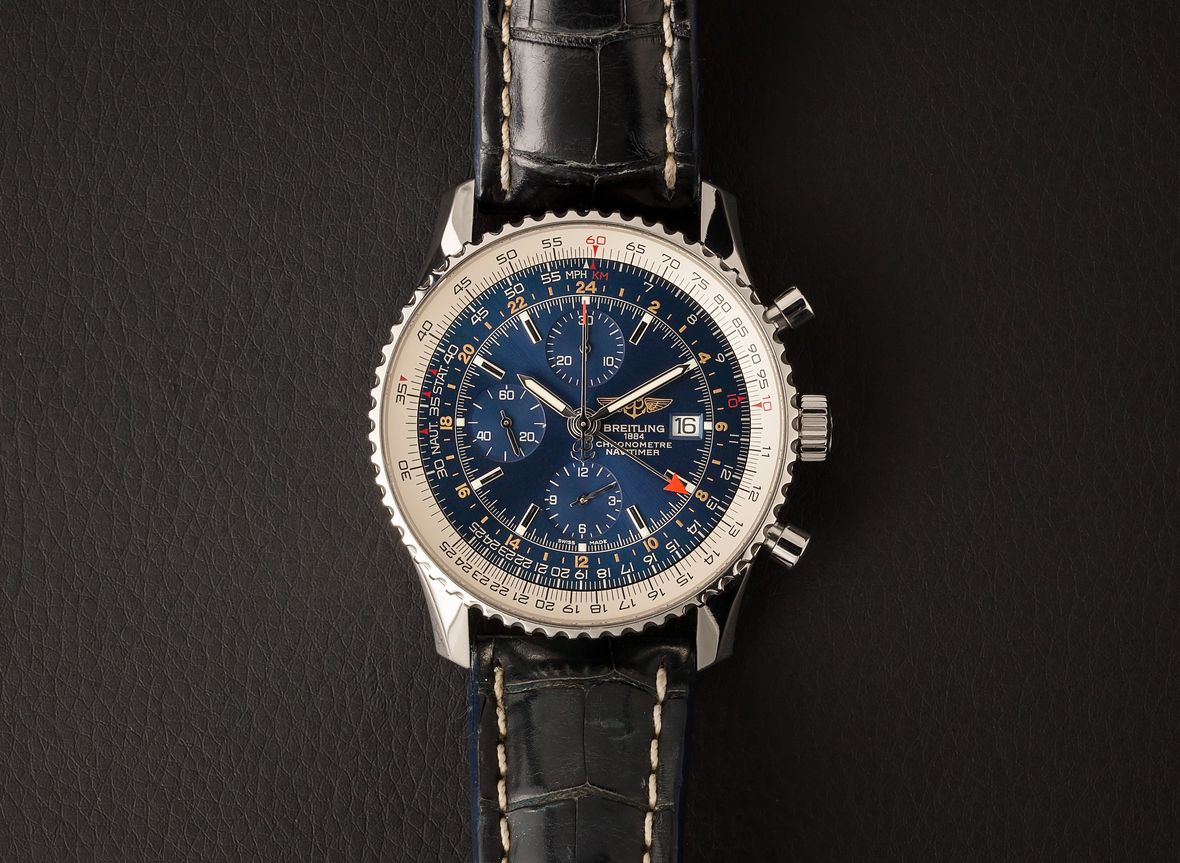
Navitimer World Key Features:
– Production Years: 2012 – Present
– Case Size: 46mm
– Materials: Stainless Steel
– Functions: Time w/ Running Seconds, Date Display, 12-Hour Chronograph, GMT Functionality
– Dial: Black or Blue w/ Luminous Hour Markers
– Bezel: Bidirectional, Stainless Steel with Aviator’s Slide Rule
– Crystal: Sapphire (Domed)
– Movement: Breitling Caliber 24
– Water Resistance: 30 Meters
– Strap/Bracelet: Stainless Steel Bracelet or Leather Strap
– Approx. Price: $7,350 – $7,600 (New); $4,000 – $7,300 (Pre-Owned)
The most famous model among pilot’s watches, the Breitling Navitimer, and its iconic slide rule bezel have been the number one choice for the true aviation enthusiast since 1952. More recently, that hardworking watch took on even more responsibilities, with the 2012 release of the Navitimer World, a 46mm model with a bonus GMT complication, adding 24-hour gradations to a dial already full of logarithmic scales.
However, while it would be easy to imagine displaying all that information (plus a date function and chronograph) would be too cluttered and confusing, it is all perfectly legible and intuitive. You could actually be forgiven for thinking the World was a standard Navi at first glance, and it is only upon closer inspection that you see the red-tipped additional hour hand and golden 24-hour numerals. Handily, the case back has been engraved with the time zones of the world’s major cities as well.
The movement is the Breitling 24, an automatic caliber based on the ETA/Valjoux 7754. Chronometer-rated, it offers users a 42-hour reserve and 28,800vph balance speed. Breitling The Navitimer World comes with either a black or blue dial, and with a selection of leather straps or Breitling’s intricate seven-link steel bracelet. Possibly the most complete pilot’s tool watch, The Navitimer World really has just about everything covered.
Panerai Luminor GMT ref. PAM01088
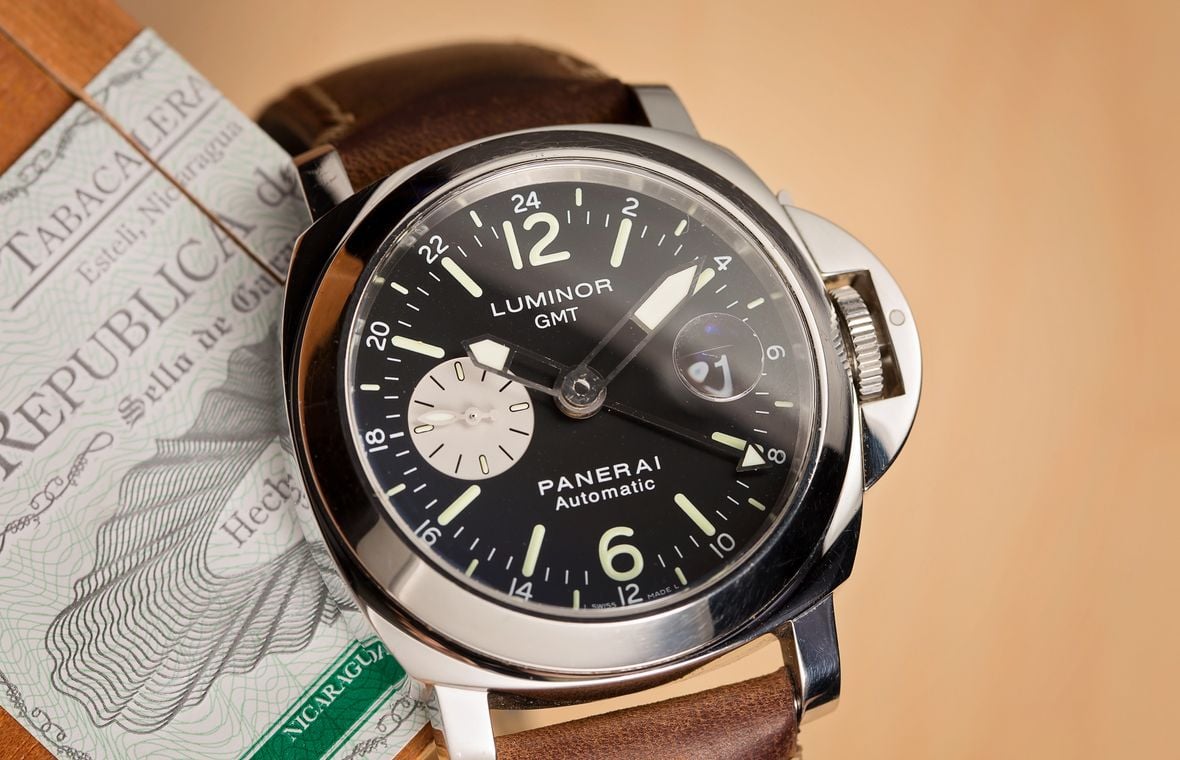
Luminor GMT PAM01088 Key Features:
– Production Years: 2016 – Present
– Case Size: 44mm
– Materials: Stainless Steel
– Functions: Time w/ Running Seconds, Date Display, GMT Functionality
– Dial: Black w/ Luminous Hour Markers
– Bezel: Fixed, Stainless Steel, Smooth Style
– Crystal: Sapphire (Domed)
– Movement: Panerai Caliber OPXXXI
– Water Resistance: 300 Meters
– Strap/Bracelet: Leather or Rubber Strap
– Approx. Price: $7,500 – $7,600 (New); $6,500 – $8,300 (Pre-Owned)
Another of the industry’s most recognizable designs, the Panerai Luminor range currently consists of more than 60 watches, ranging from simple time-only models to some extraordinary haute horlogerie examples boasting skeletonized tourbillons and equation of time moonphase complications. Among them are several GMT models, including the PAM01088, a 44mm stainless steel piece, with all the essential Panerai elements present and correct.
The dial is the definition of legibility itself, with enormous lume-drenched Arabic numerals in the proprietary font at the 12 and 6, with similarly glowing large batons for the rest. The running seconds are given their own sub-dial at the 9 o’clock and the case is the archetypal cushion shape with (of course) that signature lever-controlled bridge protecting the winding crown. However, the handset differs from the norm, with great fat cutout main hands with lumed ends, and a small arrow-tipped GMT hand pointing to the 24-hour scale around the dial’s edge. A date display sits at the 3 o’clock location, with an internal Cyclops-esque magnifying lens above.
Under the hood sits the Caliber OP XXXI, a self-winding movement (unlike some of the Luminor series) based on the ETA/Valjoux 7750. Perhaps the most widely used third-party movement ever, it actually starts life as a chronograph. However, Panerai has removed the stopwatch module and replaced it with their own GMT unit. Working away at 28,800vph, it offers a healthy 50-hour power reserve.
As for the all-important straps and bracelets beloved by the Paneristi, take your pick from the supplied Scamosciato dark brown leather, or the diving black rubber strap, each secured with a steel tang buckle. A useful and stylish addition to any collection, the Panerai Luminor GMT is a superb everyday sports watch.
Longines Spirit Zulu Time
Longines, renowned for equipping aviation legends like Hugh Herndon, Clyde Pangborn, and Amy Johnson, has elegantly tapped into its heritage with the introduction of the Zulu Time model in its Spirit collection. This model, named after the military term for Greenwich Mean Time (GMT), showcases a robust stainless steel case available in both 42mm and 39mm sizes. Inside each timepiece beats a newly developed proprietary movement, enabling the precise adjustment of the traditional hour hand and a GMT hand. This feature brilliantly tracks an additional time zone along the 24-hour bezel, which is adorned with lacquered engraved numerals set into a vibrant ceramic bezel insert.
Oris Big Crown ProPilot Timer GMT ref. 01 748 7756 4064-07 3 22 02LC
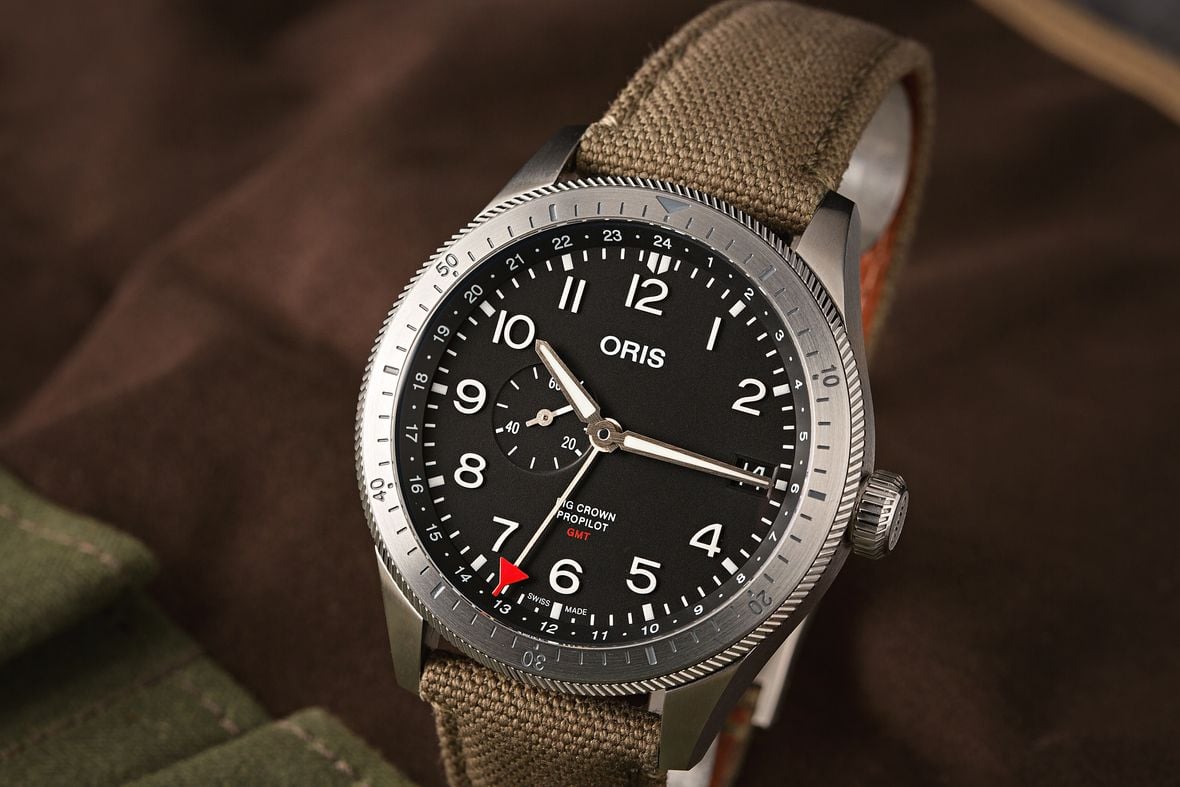
ProPilot Timer GMT Key Features Key Features:
– Production Years: 2018 – Present
– Case Size: 44mm
– Materials: Stainless Steel
– Functions: Time w/ Running Seconds, Date Display, GMT Functionality
– Dial: Black w/ Luminou Hour Markers
– Bezel: Bidirectional, Stainless Steel w/ 60-Minute Scale
– Crystal: Sapphire (Domed)
– Movement: Oris Caliber 748
– Water Resistance: 100 Meters
– Strap/Bracelet: Textile or Leather Strap; Stainless Steel Bracelet
– Approx. Price: $2,600 (New); $1,600 – $2,600 (Pre-Owned)
A brand that has always been a big favorite of ours, Oris has some of the best value for the money watches in the entire Swiss watch business. The brand’s portfolio covers four main areas: Diving, Culture, MotorSport, and Aviation, and it is within that last category that you will find the Big Crown ProPilot Timer GMT.
A more vintage aesthetic than Oris’s Aquis dive models, the ProPilot Timer GMT has all the necessary requirements of a true pilot’s watch. It has a sizable diameter of 44mm, with acres of room on the dial for large, SuperLumiNova coated indexes. The long hands and thin bezel only add to the feeling of space, and the watch’s 24-hour numerals are found around the perimeter, sitting on the dial’s raised outer flange. The GMT hand is topped with a red arrow, which looks like a top-down view of an Avro Vulcan, with its famous Delta wing. That leaves the bidirectional bezel available for a 60-minute scale, meaning that it can act as a timer too.
Additionally, both the bezel edge and the titular big crown are given aviation-style knurling to aid with grip – which is handy if you happen to be wearing gloves. The movement is the Oris 748, which is actually the Sellita SW220-1. An excellent, hardworking caliber, it has a respectable 38-hour reserve, 26 jewels, and beats at 28,800vph. Turn the ProPilot Timer GMT over and you will see through the sapphire case back that Oris has added its trademark red rotor.
As an all-round, fully-fledged pilot’s watch, the Oris Big Crown ProPilot Timer GMT ticks just about every box, and at around $2,500 (and even less on the pre-owned market) you will go a long way before you find another Swiss-made GMT watch that offers so much for so little.
Oris Aquis GMT Date

The Oris Aquis GMT Date displays time with striking clarity, thanks to its Superluminova hour markers and hands, and a GMT hand in a contrasting yellow. It features a tough ceramic 24-hour bezel, allowing for easy tracking of two time zones simultaneously. This watch, a trendsetter in stainless steel, boasts a robust case just over 43mm in diameter, a sophisticated multi-link bracelet, and a reliable self-winding movement. Whether it’s for underwater adventures or as a stylish travel companion, the Oris is designed to impress. Overall a nice watch at incredible value for any collector.
